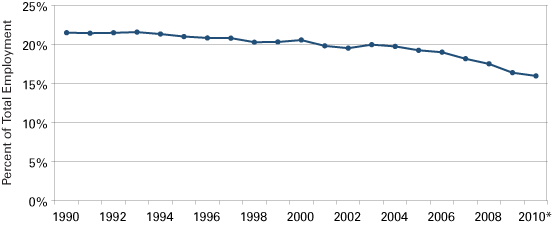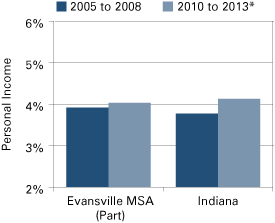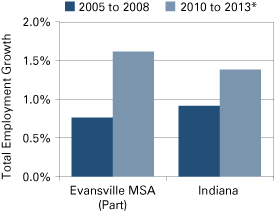Evansville Forecast 2011
Professor of Economics and Dean of Business, College of Business, University of Southern Indiana
While the Business Cycle Dating Committee of the National Bureau of Economic Research has determined that the 2007-2009 recession began in December 2007 and ended in June 2009,1 there is considerable variation across metro areas with regard to the timing, strength and persistence of the recovery. While previous post-World War II recessions ranged in length from six months to 16 months for the national economy (averaging about 10.5 months), the 2007-2009 recession was the longest recession in the postwar period at 18 months. In addition, it was the deepest recession in the postwar period: at their lowest points, employment fell by 6.1 percent and output fell by 4.1 percent.2 In comparison, employment fell by just over 5 percent and output fell by nearly 4 percent in the Evansville metro area.
In the aftermath of the 2007-2009 recession, the recovery of the Evansville metro economy appears to be as slow, fragile and filled with uncertainty as the national recovery. Following decreases in output and employment in 2009, real output, income and retail sales increased in 2010. However, the strength of these increases was far from spectacular.
The dynamics of the Evansville area labor market underscore this with a rise in the unemployment rate from 7.6 percent in September 2009 to 8.4 percent in September 2010 compared with a drop in the national unemployment rate from 9.5 percent to 9.2 percent over the same time period. In previous business cycles, aggregate hours and employment have frequently reached their troughs later than when the recession has officially ended.3 The rise in the unemployment rate in the Evansville metro area during 2010 suggests that household employment will also reach its trough later than the official date indicating the end of the recession.
An examination of the output and employment performance of the national economy since June 2009 indicates that the current recovery has been the slowest in output growth in the first five months compared to the other postwar recoveries and the slowest in terms of employment growth in the first eight months compared to previous postwar recessions. The Evansville metro area has coped with the recession slightly better than many metro areas in terms of relatively lower output loss and a relatively lower unemployment rate during 2008 and 2009. At the same time, it will take a number of years to recover the jobs lost during the recession. It is projected that the Evansville metro area will take less time (three to four years) than the national economy to return to employment levels prior to the recession.
In 2010, Evansville experienced job gains in traditional recession-resistant sectors such as health care and education, but employment increases were also evident in retail, wholesale trade, and the professional and business services sector. In 2010, nominal personal income is estimated to increase by 1.5 percent and real gross metro product is estimated to increase by 3.4 percent. The manufacturing sector continues to be an important base to metro area household incomes and consumer spending activity even as the economy adjusts to an ongoing diversification away from manufacturing-industry dependence (see Figure 1).
Figure 1: Manufacturing Employment as a Percent of Total Nonfarm Employment in the Evansville Metro, 1990 to September 2010

*Shows September 2010 number rather than the annual average.
Source: IBRC, using Bureau of Labor Statistics data
The Evansville economy tracked the United States economy in 2010. Homeowners experienced some home price depreciation as existing home prices decreased from an average of $88,200 in 2009 to $87,300 in 2010 and mortgage originations are estimated to decrease from nearly $1.5 billion in 2009 to $1.3 billion in 2010. Between 2009 and 2010, single-family housing permits are estimated to have increased by 22 percent and personal bankruptcies per 1,000 persons increased from 6.2 to 7.8.
Given the proportion of output that is sold outside the metro area the strength of the recovery in the Evansville area is linked to the strength of the broader economy. As the demand for locally produced goods returns to the level of the preceding five years, personal income and output growth in the next year will be at higher levels than in 2010.
In 2011, for the Evansville metro area, output is forecasted to increase by 3.2 percent, the number of jobs is projected to increase by 1,800 and nominal personal income is projected to grow 3.9 percent. Figures 2 and 3 provide a comparison of forecasts for the Indiana segment of the Evansville economy and the state of Indiana for the 2010-2013 period.
Figure 2: Average Growth of Personal Income

*Includes forecasted data
Source: Center for Econometric Model Research
Figure 3: Average Growth of Total Employment

*Includes forecasted data
Source: Center for Econometric Model Research
As one of the most manufacturing-dependent metro areas in the nation, the Evansville economy was noticeably impacted by the current recession. Since 2000, Evansville’s manufacturing workforce has fallen by 26.3 percent or about 9,700 workers as of September 2010, though this is better than the 32.9 percent reduction in Indiana’s manufacturing workforce over the same period.4 At the same time, manufacturing earnings as a share of total earnings has remained stable at about 29 percent between 2001 and 2010 in the Evansville metro economy.
Since the pace of structural change in the Evansville economy slowed during the past year, there are likely to be added transitional challenges as the regional economy adjusts from its manufacturing-industry dependence, particularly in nondurable manufacturing (see Table 1). In addition, the metro has a higher percentage of the elderly age cohort than the state and a lower proportion of the youth cohort than the nation, which places greater pressures on in-migration as a source of the human capital needs of the region.
Table 1: Manufacturing Percent of Total Employment, September 2010
| Industry | Evansville Metro | United States | Indiana |
|---|---|---|---|
| Manufacturing | 16.0% | 9.0% | 15.7% |
| Durable Goods | 52.9 | 61.4 | 71.0 |
| Nondurable Goods | 47.1 | 38.6 | 29.0 |
Source: Bureau of Labor Statistics and Indiana Department of Workforce Development
Notes
- See www.nber.org/cycles/cyclesmain.html for more information.
- See www.minneapolisfed.org/publications_papers/studies/recession_perspective/.
- See www.nber.org/cycles/sept2010.html.
- The 2010 data is based on September values instead of year to date.
Also in this Issue…
- Outlook for 2011
- International Outlook for 2011
- U.S. Outlook for 2011
- Financial Outlook for 2011
- Housing Market Outlook for 2011
- Indiana's Outlook for 2011
- Indiana's Agricultural Outlook for 2011
- Anderson Forecast 2011
- Bloomington Forecast 2011
- Columbus Forecast 2011
- Evansville Forecast 2011
- Fort Wayne Forecast 2011
- Gary Forecast 2011
- Indianapolis-Carmel Forecast 2011
- Kokomo Forecast 2011
- Lafayette Forecast 2011
- Louisville Forecast 2011
- Muncie Forecast 2011
- Richmond Forecast 2011
- South Bend and Elkhart Area Forecast 2011
- Terre Haute Forecast 2011




